About Mandalay
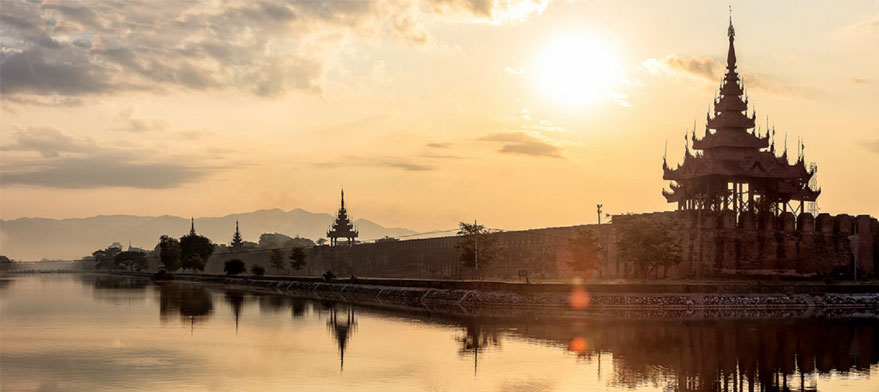
Mandalay is the second largest city of Myanmar, with a population of Mandalay region is over 6 million and over 1.2 million is within Mandalay City, stands the cultural heart of Myanmar where the most refined arts, traditions of dance, music and drama. Mandalay is the royal capital of the last monarchy of Myanmar.
Mandalay is the economic Centre of upper Burma and considered the Centre of Burmese culture. It is also known for its fine gold and silver crafts, wood and marble carving, making bronze Buddha image, silk thread weaving and ancient tapestry. Besides handicrafts workshops, interest places are Zeycho Market, Shwenandaw Monastery, Kuthodaw Pagoda and Mandalay Hill. Mandalay has wide lanes filled with bicycles and motorcycles and is known for its cultural diversity. Mandalay International Airport is also the gateway to Myanmar. It is only over an hour's flight from Yangon. By road, it takes about 14 hours by Express coaches; and about 14 hours by train from Yangon.
Mahamuni Buddha Temple
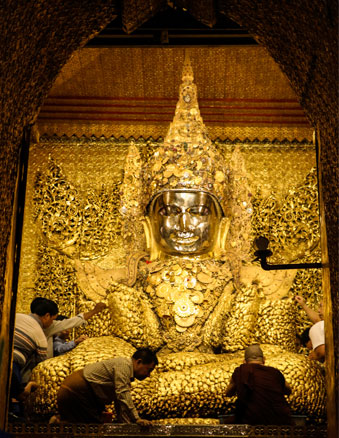
If you have plan to travel Mandalay, one place you should not miss is that “Mahamuni Buddha Temple” (also called the Mahamuni Pagoda) where the big Buddha image is venerated and it is seen as an expression of representing the Buddha’s life and major pilgrimage site. It was built in 1785 by King Bodawpaya of the Konbaung dynasty. Mandalay citizens believe that Mahamuni Pagoda is one of the “wish-granting” pagoda. Most of the male devotees apply gold leaf to the image which is called shwe chain Burmese to pay respect to the Buddha image. As a result, the Mahamuni Budda is covered with a thick layer of gold leaf of about 15 centimeters. Several old photos of the image in the temple show the difference in the outline of the image between about a century ago and now. One manner, famous among foreigners that every morning at around 4am the Buddha image ritual is performed. Viewed by a great number of Buddhist devotees, the men up front, the women behind a rope, a very senior monk of the Mahamuni temple assisted by a number of helpers washes the face of the images and brushes the teeth. The ritual is performed in great detail and takes considerable time. There is a museum at Mahamuni Pagoda as well, which displays information about the various places in the life of the Buddha, from His birth place in Nepal, the site where He reached enlightenment and the site of His passing into final Nirvana. There are also maps that explain about the spread of Buddhism across Asia during the last 25 centuries.
Golden Palace

Then, continue your visit to the last “Golden Palace” of the last Burmese monarchy which was the primary royal residence of the last two kings of the country, King Mindon and King Thibaw. The palace was constructed, between 1857 and 1859 as part of King Mindon’s establishment of the new royal capital city of Mandalay. The plan of Mandalay Palace largely follows the traditional Burmese palace design, inside walled fort surrounded by a moat. The palace is at the centre of the citadel and faces east. All buildings of the palace are of one story in height. Encircling the citadel is a picturesque 60m-wide moat with a number of bridges protects the large complex which includes audience halls, throne halls, a monastery, a watchtower, a court building, a tooth relic building and a library where the Buddhist scriptures were kept. Golden Palace is one of the major tourist destination in Mandalay as well.
Mandalay Hill
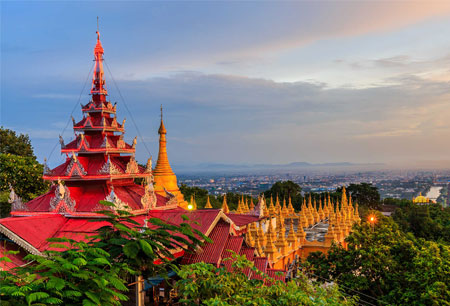
 Everyone who arrived in Mandalay, the ancient capital of Myanmar usually goes to Mandalay Hill as well, the landmark of Mandalay. If you reach the top of the hill, can pay homage to Su Taung Pyi Pagoda. Moreover, the visitors could view the elegant craftsmanship with two Snakes raising the hoods up. Besides, there are shops of Myanmar traditional handmade toys, gifts etc.There are four covered stairways called saungdan leading up the hill from the south, southeast, west and north. A one-way motor road saves time and also makes it accessible for those who are unable to climb up the stairs, leading to an escalator and a lift to the pagoda at the summit. At the evening time, you can enjoy the sunset on top of “Mandalay Hill” and admire the beauty of Mandalay City. Sunset over the river and the western hills as seen from Mandalay Hill can be a wonderful experience, and crowds of tourists may be encountered in the evening enjoying it.
Everyone who arrived in Mandalay, the ancient capital of Myanmar usually goes to Mandalay Hill as well, the landmark of Mandalay. If you reach the top of the hill, can pay homage to Su Taung Pyi Pagoda. Moreover, the visitors could view the elegant craftsmanship with two Snakes raising the hoods up. Besides, there are shops of Myanmar traditional handmade toys, gifts etc.There are four covered stairways called saungdan leading up the hill from the south, southeast, west and north. A one-way motor road saves time and also makes it accessible for those who are unable to climb up the stairs, leading to an escalator and a lift to the pagoda at the summit. At the evening time, you can enjoy the sunset on top of “Mandalay Hill” and admire the beauty of Mandalay City. Sunset over the river and the western hills as seen from Mandalay Hill can be a wonderful experience, and crowds of tourists may be encountered in the evening enjoying it.
Kuthodaw Pagoda
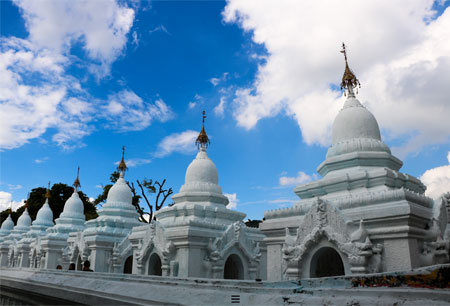
After that, proceed to “Kuthodaw Pagoda” was built by King Mindon, father of King Thibaw to leave a great work of merit for future generations which lay at the foot of Mandalay Hill. It comprises of a gilded pagoda, surrounding the pagoda are 729 shrines, each containing a single marble slab inscribed with Buddhist teachings written in ancient Pali language and it is called “the world’s largest book”. One more slab (number 730) tells the story of how the world’s largest book came about.
Shwenandaw Monastery
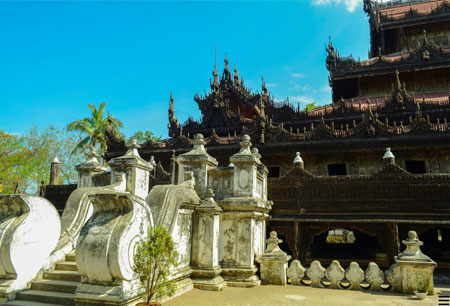
Additionally, we would like to highlight one of the ancient place named “Shwenandaw Monastery” meant “Golden Palace Monastery” located near Mandalay Hill, Mandalay Region as well. It was built in 1880 by King Thibaw Min. it is one of the finest examples of traditional 19th century wooden monastery building in Myanmar. The building was heavily gilt with gold and adorned with glass mosaic work. The monastery is known for its teak carvings of Buddhist myths, which adorn its walls and roofs. The monastery is built in the traditional Burmese architectural style.
Besides, there are several ancient capitals around Mandalay such as Amarapura, Sagaing, Inwa, Mingun where Kongboung dynasty kings established their capitals respectively.We would like to suggest to go ancient capitals around Mandalay as well if you have one or two days extra to visit.
Amarapura
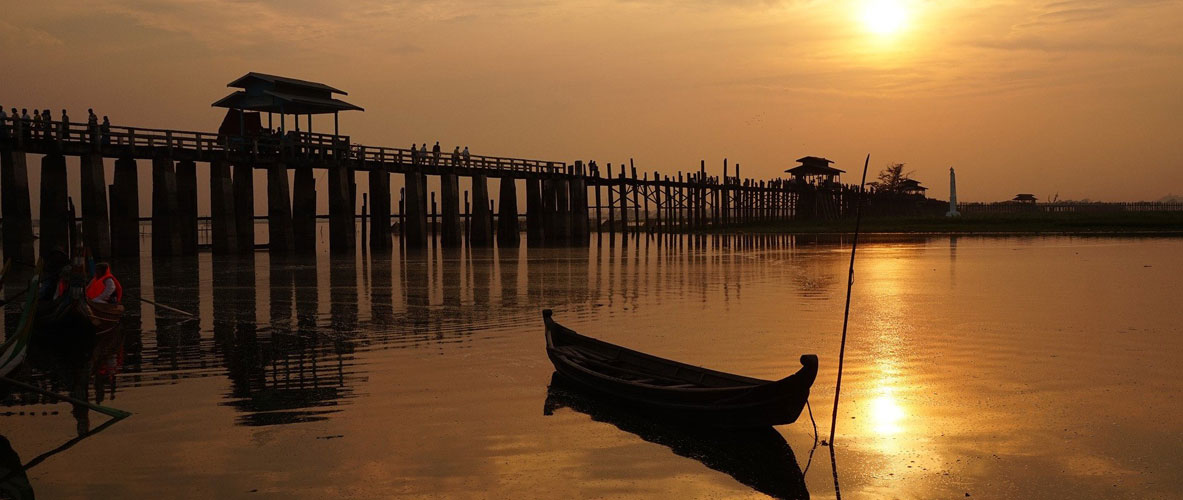
Amarapura is not far from Mandalay, situated about 11 km south of Mandalay and on the left bank of the Ayeyarwaddy River. One of the famous culture is for fabric and silk weaving which are locally-produced items in Myanmar. Most of the tourists, they are strong interested in this culture.
There is “U Bein Bridge”, longest teak wooden bridge in the world, was built by U Pain, is about 1,200 meters long and crosses Thaungthaman Lake.
Then, “Mahagandayon Monastery”, one of the biggest Buddhist University in Upper Myanmar, is the most interesting site in Amarapura and over 1,000 monks study the Buddhist teachings there.
